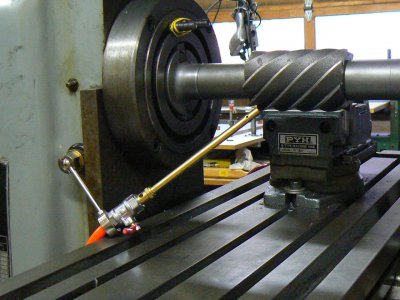Hi,
I got my old Van Norman Mill about a week ago and have spent time until today cleaning it, changing sump oils, reducing backlash etc. Basically getting accustomed to the machine and tuning it up per the Manuel.
Today I bit the bullet and made my first cuts. I clamped down a piece of 1/2 inch steel bar stock (mild steel, I don't know the exact number or hardness). The Speed and Feed, as best I could tell, suggested an RPM of about 650 for the 1/2 inch 4 flute HHS end cutter I had in a collett in the spindle. The feed rate was hard for me to deal with since the machine is currently pure manuel-- no motor feed--so I just tried to "make chips".
My first two cuts across this 4" steel bar were only about 1/16 inch deep and seemed to go fine.
So I cranked the table up for a 1/8 inch depth cut and this went pretty well, but the tool started 'smoking" a bit-- so I used a little foaming cutting oil-- but this didn't seem to stick around long enough to help-- I made it across the 4 inches OK.
I had read that a cutter should be able to cut about half of the cutter diameter-- so I cranked the table up so the cut would be about 1/4 inch deep. This didn't go very well. I made it about a half inch into the material and the tool was smoking quite a bit and intermittently was spinning inside the collett--so I stopped. I tightened the draw bar to incease the collett hold on the tool, but it was already prettty tight- so I didn't think this was the problem.
What am I doing wrong. Is the tool dull (got it with the mill-- no visible chips under magnification. It's hard to say how fast I'm feeding the table. I don't want to go to slow (read that this make the tool "rub and overheat") and don't know if I was going to fast. Why is the tool spinning inside the collett-- I did clean light surface rust out of the collett then coated with WD40-- maybe too slippery? What's with this "smoking" is that expected if I don't have a high volume cooling system?
Sorry about the long post but I wanted to give as much info as possible.
Thanks in advance,
Bob
I got my old Van Norman Mill about a week ago and have spent time until today cleaning it, changing sump oils, reducing backlash etc. Basically getting accustomed to the machine and tuning it up per the Manuel.
Today I bit the bullet and made my first cuts. I clamped down a piece of 1/2 inch steel bar stock (mild steel, I don't know the exact number or hardness). The Speed and Feed, as best I could tell, suggested an RPM of about 650 for the 1/2 inch 4 flute HHS end cutter I had in a collett in the spindle. The feed rate was hard for me to deal with since the machine is currently pure manuel-- no motor feed--so I just tried to "make chips".
My first two cuts across this 4" steel bar were only about 1/16 inch deep and seemed to go fine.
So I cranked the table up for a 1/8 inch depth cut and this went pretty well, but the tool started 'smoking" a bit-- so I used a little foaming cutting oil-- but this didn't seem to stick around long enough to help-- I made it across the 4 inches OK.
I had read that a cutter should be able to cut about half of the cutter diameter-- so I cranked the table up so the cut would be about 1/4 inch deep. This didn't go very well. I made it about a half inch into the material and the tool was smoking quite a bit and intermittently was spinning inside the collett--so I stopped. I tightened the draw bar to incease the collett hold on the tool, but it was already prettty tight- so I didn't think this was the problem.
What am I doing wrong. Is the tool dull (got it with the mill-- no visible chips under magnification. It's hard to say how fast I'm feeding the table. I don't want to go to slow (read that this make the tool "rub and overheat") and don't know if I was going to fast. Why is the tool spinning inside the collett-- I did clean light surface rust out of the collett then coated with WD40-- maybe too slippery? What's with this "smoking" is that expected if I don't have a high volume cooling system?
Sorry about the long post but I wanted to give as much info as possible.
Thanks in advance,
Bob


